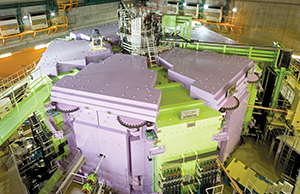Dec. 6, 2013 RIKEN Places Physics / Astronomy
Revealing how it all began
The Nishina Center for Accelerator-Based Science strives to shed light on the creation of the Universe as well as questions closer to home.
 © 2013 RIKEN
© 2013 RIKEN
Based at the RIKEN Wako campus, the Nishina Center for Accelerator-Based Science (RNC) is a leading international center for nuclear physics research. Inaugurated in 2006 and continuing an 80-year history of ground-breaking accelerator-based research at RIKEN, the center is named after Yoshio Nishina who constructed Japan’s first cyclotron in 1937. The RNC is renowned for its study of the nuclei of heavy elements and how they first formed and also conducts pioneering accelerator-based research by applying radioisotopes to a range of fields—including agriculture and medicine.
Supersized accelerator
The RNC’s key facility is the Radioactive Isotope Beam Factory (RIBF), a world-leading heavy-ion research facility. The RIBF is a multistage accelerator complex whose final-stage accelerator, the Superconducting Ring Cyclotron, measures 18 meters in diameter and weighs 8,300 tons, making it the largest of its kind in existence. The integration of the RIBF’s five cyclotrons and superconducting radioactive isotope beam separator allows the facility to generate some of the most intense ion beams in the world. Through the utilization of superconductivity, the RIBF is considerably more energy-efficient than similar facilities that only use conventional accelerators.
Data collected at the RIBF was instrumental in achieving a major breakthrough at the RNC in 2012—the unambiguous identification of element 113. Early signs of the element were detected in 2004 and 2005 by researchers using the RIKEN Heavy-ion Linac, a linear particle accelerator, although a further seven years of painstaking experimentation at the RIBF were required to obtain a set of conclusive data. Currently under review by an international committee, the claim—if accepted—would mark the first time a predicted element has been synthesized by a country in Asia.
By using heavy-ion irradiation to induce mutations in flowers, rice and wheat, the RNC has gained international attention for creating new varieties of plants with shortened breeding cycles. Two new types of ornamental cherry tree that have larger flowers and bloom more frequently have also been developed. At the same time, the RNC is exploring the production of radioisotopes for pharmaceutical and environmental applications.
Discovering the undiscovered
The RNC currently employs 696 members of staff, including 112 women and 112 foreign researchers, and has a budget of over 3 billion yen for the 2013 fiscal year. Within the center, the RIBF Research Division leads two ambitious initiatives: the Euroball-RIKEN Cluster Array (EURICA) Project that brings together 51 institutions from 16 countries to investigate nucleosynthesis in supernova explosions, and the SAMURAI (Superconducting Analyzer for Multi-particles from Radioisotope beams) study of stellar nucleosynthesis.
Looking ahead, the RNC hopes to utilize the capabilities of the RIBF to uncover at least 1,000 so-far-undiscovered atomic nuclei from a pool of over 10,000 predicted by theory. The center will also continue its quest to elucidate the formation of heavy elements in the Universe as well as contributing to applied research that aims to overcome food and energy shortages.
